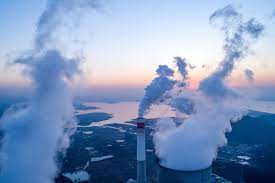Earth-warming emissions by European Union economies fell by an aggregate 8.3 percent in 2023 compared to 2022, helped by growth in renewable power production, the European Commission reported Thursday.
Last year marks the second-biggest annual drop in EU greenhouse gas emissions in decades, after 2020, when the coronavirus pandemic drove a 9.8 percent year-on-year drop in emissions, according to the report on the Commission’s website.
While the decrease in 2023 came against the backdrop of general stagnation in the EU economy, with gross domestic product growth landing at 0.5 percent in real terms, it “is clearly linked to the acceleration of the energy transition”, the Commission declared. It explained that the decline had been mostly due to the energy industry’s 18 percent year-on-year decrease in emissions to 167 million metric tons of carbon dioxide equivalent (MMtCO2eq).
“This drop was due to a substantial increase in renewable electricity production (primarily wind and solar), at the expense of both coal and gas and, to a lesser extent, a decrease in both electricity and heat supply (-3.1 percent and -2.3 percent respectively) compared with 2022, and to the recovery of hydro and nuclear power”, the EU Climate Action Progress Report stated.
“Preliminary data for 2023 20 show that renewable energy sources were, for the first time by such a clear margin, the leading source for electricity generation (44.7 percent versus 32.5 percent from fossil fuel and 22.8 percent from nuclear power)”.
Power from fossil fuel-fired generating units fell 19.7 percent against 2022. Natural gas lost its position as the second-largest power source in the 27-member bloc behind nuclear. Wind overtook gas with 16 gigawatts of capacity installed last year, according to the report.
EU emissions from domestic transport (excluding carbon dioxide gave off by the aviation sector), buildings, agriculture, small industry and waste fell two percent year-on-year.
“In the EU, verified emissions from aircraft operators increased compared to 2022 by around 9.5 percent as the industry continued to rebound from the very low levels of activity during the COVID-19 pandemic”, the Commission said.
The EU’s carbon sinks increased 8.5 percent year-on-year, “although approximated emissions remain subject to large revisions”, it said.
Compared to 1990, the EU’s emissions in 2023 fell 37 percent despite GDP growing 68 percent over the three decades, “showing the continued decoupling between emissions and economic growth”, the Commission said.
“The decades-long decreasing trend in the EU’s GHG emissions means that they now represent 6.1 percent of global emissions, which is a sharp decrease from 14.9 percent in 1990”, it said.
Wopke Hoekstra, EU Commissioner for Climate Action, commented in a separate statement by the Commission, “As we head off soon to COP29, we once again demonstrate to our international partners that it is possible to take climate action and invest in growing our economy at the same time”.
The Commission cautioned, “While this report gives encouraging news on EU emission reductions, the last year has also seen more catastrophic events and lost lives and livelihoods, driven by our already changing climate, and global emissions have not yet peaked”.
“In 2023, Europe experienced its largest wildfires ever recorded, one of the wettest years on record, major marine heatwaves, widespread devastating flooding, and a continuing increase in temperatures”, added the statement on the Commission’s website.
For the EU to achieve its goal of cutting emissions by at least 55 percent by 2030 relative to 1990 and becoming a net-zero economy by 2050, “an emission reduction of 134 MtCO2-eq needs to be achieved every year from now until 2030, on average”, the report said. “This is a slightly larger reduction compared with the annual average cut of about 120 MtCO2-eq seen over 2017-2023”.

 Iran Energy News Oil, Gas, Petrochemical and Energy Field Specialized Channel
Iran Energy News Oil, Gas, Petrochemical and Energy Field Specialized Channel



